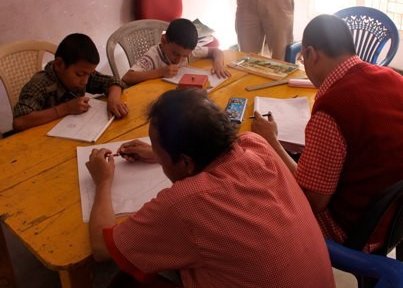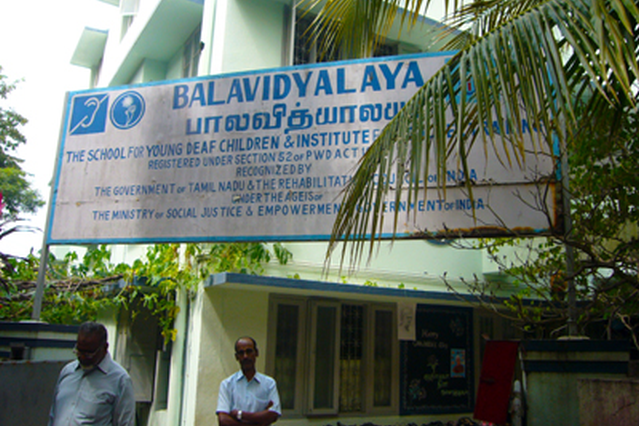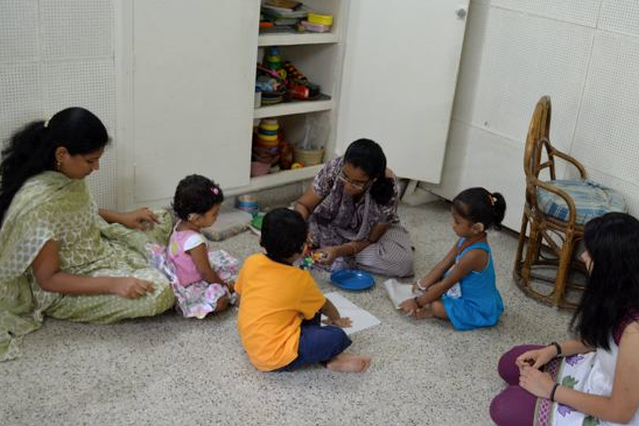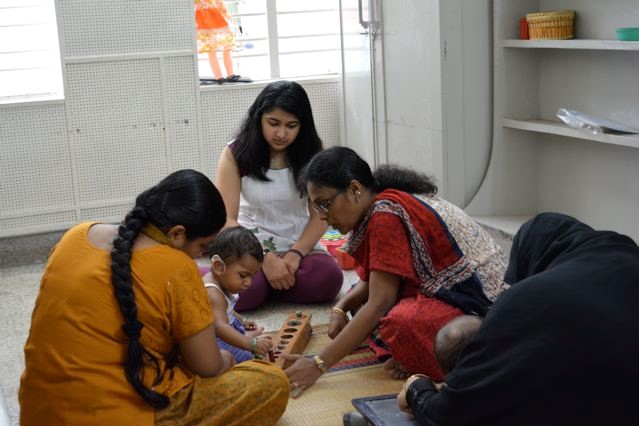Site Visit Reports
Asha for Education volunteers make it a point to visit a project when they travel to India. Here are a few notes from their field visit ...
Would you like to visit?
Please contact us if you would like to visit any of our projects in India
Contact Us-Ravi Kandikonda, Asha Dallas.
Before we present this report, Asha for Education offers its heartfelt Congratulations to Kailash Satyarthi on being awarded the Nobel Peace Prize. He is truly an inspirational figure who has undertaken such a pressing cause. On this occasion we encourage you to read more about Bachpan Bachao Andolan, the organization started by Satyarthi, and understand the importance of rescuing children from servitude. Bal Ashram is a rehabilitation center where rescued children receive basic education and vocational training to help them transition into society as well rounded individuals. The Dallas chapter of Asha has been supporting Bal Ashram, run by Sumedha Kailash, since 2006.
The project is located in the town of Viratnagar, which lies in the Aravalli mountain range between the major cities of Jaipur and Alwar in Rajasthan. Our visit began with a one and half hour taxi ride from Jaipur along NH 8 early in the morning. We reached the Ashram around 9:15am and were welcomed by Adesh.
The Ashram itself seemed like a sanctuary for anyone wanting to get away from hustle bustle of city life, but its more serious role, of providing shelter and bridge school, became slowly apparent. It had a small front office, boarding rooms for the kids, a prayer room, a library and a dining room. The kids were near the prayer room while we were welcomed and told that Kailash and Sumedha were only a few minutes away from reaching the Ashram. As soon as this was announced, the kids in the Ashram got super excited and started shouting happy slogans to welcome them. As the car came inside and they stepped out, only after all kids had taken blessings from Kailash and Sumedha did we get to meet them. We spent some time talking about the Ashram and got to hear about the international tour that Kailash had just returned from where he was a guest speaker in the Parliaments of four countries, which lets him take his message of eradicating child labor around the world. He is also the founder of Global March against Child Labor and has received numerous awards and recognitions for his work to free children of child labor.
Meanwhile, the children had all settled down near the prayer room sitting in organized rows and were ready to meet their visitors, my wife and me. As we entered the area, a couple of young girls came forward and applied the traditional ‘tilak’ to our foreheads and gave flower garlands. We were seated in two chairs and then started conversing with the children. We asked them to introduce themselves, one by one, and tell us where they are from and what they want to become when they grow up. The children were excited in telling us what they wanted to become – policemen, doctors, painters, electricians etc. At one time, it got a bit emotional when one of the boys said he used to beg on the streets before he was rescued by the Ashram. It was heartening to see where he was today compared to the life he was leading.
Asha Dallas supported the construction of makeshift classrooms for the children of Banjara community. The chapter also funded a borewell that helped one community save lot of time that was spent in sourcing water for daily use.
It was time then to play some cricket with them and quick game of carrom board with the youngest children. The playground was surrounded by many trees. We were given a tour of the library and the hostel rooms, which seemed clean and well maintained. The children were being given very good health and hygiene training as part of their bridge course.
Asha Dallas supported the construction of makeshift classrooms for the children of Banjara community. The chapter also funded a borewell that helped one community save lot of time that was spent in sourcing water for daily use. I had the time to visit two such communities, which were slightly away from the Ashram. Adesh accompanied us to the first community, which was a collection of huts. The children were prepped regarding our arrival and were sitting in the classroom reading their notebooks and talking to each other. When we arrived here, we were again welcomed with some more ‘tilak’ and flowers. We spoke at length with the teacher who was available for the visit. He is the sole teacher who lives nearby and helps with teaching the kids basic reading, writing and speaking. The make shift classroom was simply a four pillared structure with a thatched roof and no walls. I clearly saw a need to put a wall around the structure that gives more protection from the local animals (goats, dogs etc.), rain and hot winds during summer.
We went to the second school where we had helped install a borewell. I actually pumped some water and drank from the bore; it tasted good. I was so happy to see a direct benefit that the Dallas chapter was able to provide to the community. The elders in the community (mostly mothers and grand mothers) came forward to speak to us thanking us for the borewell and asking us to fund the construction of a wall around the make-shift school.
We got back to the Ashram just in time for some hot lunch that was prepared in the Ashram for the children and the visitors. We had a very nice chat with Kailash, Sumedha and a visiting intern from Britain. We were then given a very warm send-off to the airport and we returned to Hyderabad with a lot of memories, and a sense of urgency to help the Banjara community.
-Satyajit Nath, Asha Seattle
I met Lanu Aimol, the founder of Society for Health & Educational Development (SHED), in Guwahati on March 19, 2014. I have met him twice earlier, in the last two years. Through my interactions, I have seen that Lanu is dedicated to take care of underprivileged children – both able-bodied and differently-abled – and provide them a safe place to get their education and a sense of dignity.
First visit in 2011
When I first met Lanu in 2011, I was amazed to note that he had a full-time job as a mental health practitioner in a government department, while running a school for disabled children as a separate NGO. In addition, I also found that he regularly contributes a portion of his government salary to run SHED.
Back in 2011, SHED operated from a rented building in Bhetapara (close to the capital town, Dispur). When I visited the school, I was struck by Lanu’s and the staff’s dedication to the children. The staff runs the administrative office taking care of bills, student fees, project proposal data, as well as day-to-day logistics. I interacted with some of the children in the school. The disabilities included intellectual disabilities/mental retardation (MR), cerebral palsy (CP), Down’s syndrome, epilepsy, sight-disability, as well as physical disability. It was humbling to interact with the children.
Bimola, who has sight-disability, sang Assamese and Hindi songs beautifully. Bhaskar, who has Down’s syndrome, danced the Bihu dance with grace and energy. I also met with Rafiqul, whose right hand is amputated, who showed tremendous energy and joy when he came to meet with Lanu in his office.
Second visit in 2012
SHED was witnessing a crisis when I visited them in 2012. The landlord and neighbors in the rental building in Bhetapara were trying to push SHED out of the neighborhood. Their unfounded fear was that the disabilities in those children, would somehow rub off on their families. However, after some investigation, I found that the real issue was the landlord’s apprehension that the value of their property will be reduced due to the presence of an “unwanted entity” in the neighborhood. Even though Lanu and his teachers tried to reason with the landlord and the neighbors, SHED eventually moved to a plot of land in Sonapur, over 20 kms from the Bhetapara building. I visited the new location in November 2012.
In 2013, with some support from Assam Foundation of North America and Lanu’s own personal funds, SHED completed the formalities of acquiring this piece of land. Construction started in December 2013, with Lanu and the rest of the team pitching in to construct the new school building.
Asha’s support will help SHED continue to employ good staff members, provide necessary hostel capacity to admit hearing impaired children, and make the school infrastructure safer for the children from its current temporary settings, particularly in the rainy season and in winter.Support SHED
Third visit in 2014
When I caught up with Lanu during my March 2014 visit, it was great to know that SHED and the students had made the transition to Sonapur really well. It was also good to see that the plans to extend support to non-disabled students were also becoming real.
SHED and the team faced many challenges in the months since then, including the water supply in that remote location being cut off. They were able to get a ringwell installed urgently, with support from Assam Foundation of North America, to ensure the children’s health was not impacted. The lack of adequate hostel facilities and good quality classrooms that are weather proof continue to be challenges for SHED.
Given my observations noted above of the consistent ability of the SHED team to overcome obstacles, I have no doubt that they will continue to do everything needed in their power to solve those problems. The proposal from SHED to Asha this year, if approved, will enable SHED to overcome those obstacles faster, and serve even more differently-abled and able-bodied children of underprivileged backgrounds in the area.
– Kirthna Subash, Asha Minnesota
Background:
This hearing impaired school provides a learning environment with a student-teacher ratio of 4:1, at absolutely no cost for the families. Balavidyalaya believes in the philosophy that it is the right for every child to have chances to learn to talk. The ultimate goal of the school is not only to develop age appropriate language skills in either English or Tamil for young children, but the curriculum followed at school prepares each and every child to participate in the mainstream education at the earliest possible age. The school also has its own teacher-training program (DTYHI) which is recognized by the Rehabilitation Council of India (RCI) and the Government of Tamil Nadu. Balavidyalaya has a Diagnostic Centre, which they use to diagnose the children and prescribe suitable hearing aids, and also to carry out periodic assessments to ensure the children get the maximum benefit from the hearing aids.
Number/Age of Students: 100 between the ages of 6 months and 6 years
Number of Teachers: 20
Number of Classrooms: 18
Average income of families: Rs. 10,000/mo
Min income: Rs. 5,000/mo (plumber’s son)
Max income: Rs. 1.1 lakh/mo
Observations
Teachers: I found that the teachers were very enthusiastic about helping each child. The children aged 3-6 years were assigned in a 1:4 teacher to student ratio classroom that seems to work well. Teachers seemed to know each student and the families on a personal level, and were able to update the parents on their child’s progress at the end of the school day. Children below 2 years are assigned a 1:1 or 1:2 ratio, and a parent is strongly encouraged to join the child for the lessons as well.
Students: The majority of the students looked happy to be there, and seemed comfortable in their environment. They listened to the teachers and were excited to show me everything they were learning. Parents in the early intervention program for children that are just a few months old, played a huge role in helping their kids follow the teacher’s instructions and stay on task, whereas, children above 2 years old were very independent and didn’t need parents sitting with them in class.
The Common Causes of Hearing Impairment for Balavidyalaya Students are rubella and genetic syndromes. These causes that cause the hearing impairment in 40% of the children in Balavidyalaya, occur as a result of marriages within the same family (especially between second cousins). In fact, 50% of the families in Balavidyalaya have consanguineous marriages. In order to decrease the percentage of hearing impaired, Balavidyalaya has spent the last two years travelling to colleges and secondary schools all over Tamil Nadu in order to speak to students about the harms of consanguineous marriages.
Funding
One third of Balavidyalaya’s funds come from the Government of Tamil Nadu, and two third of the funding comes from Asha-MN and donors in India. The other organization supporting the school is Apex Foundation, located in Virginia, that gives them once a year donation and supports their website and online tools for the school.
Asha-MN supports new equipment necessary for teaching effectively that is expected to last for a couple of more years. However, one of the main teacher learning materials Balavidyalaya has trouble funding is textbooks. Because Balavidyalaya has its own unique curriculum that aids them to teach children verbal communication skills, they require special textbooks (licensed by the Government of India) that are different from those used by other hearing impaired schools in Tamil Nadu. These textbooks are difficult for the school to afford, as they are specifically for Balavidyalaya and therefore, more expensive. Last year they were able to fund the books, but this next school year they are not sure if they can.
– Amit Sharma, Asha Silicon Valley
Project Background
Seva Mandir is an NGO that has been working in Udaipur district for over five decades with objective of rural institution development, sustainable livelihoods, community rights, and empowerment through education. The work of the organization spans entire Udaipur district and has been primarily divided between (a) Natural Resource Development, (b) Education, (c) Health, (d) Women and Child rights, (e) Village Institutions and Panchayati Raj.
Asha for Education -Silicon Valley chapter (AfE-SV) has been supporting Seva Mandir’s education program in entire Badgaon block of Udaipur district since 2007. AfE-SV & Seva Mandir reach over 1400 children in Badgaon block through 20 Non-Formal Education centers (Shiksha Kendras) and upto 5 Activity Centers in government schools. The Activity Centers work to improve the quality of government schools in Badgaon block and have shown tremendous improvement in quality as well as capacity of these schools.
Maruwas NFE Center
Maruwaas is one of the oldest NFE centers and is in close proximity of Ahmedabad-Udaipur highway. This place has changed quite dramatically over the years, I was told by Farheen. The village is right off of NH-8 and at the face of it seems well connected and would make one feel that it’s a suburban area quite a bit different from remote village like the ones in Selu or Delwada. The reality is a bit different though. The highway completion has brought access to highway road transport and more people are more freely traveling to the city for work, as well as it has given daily wage labor contractors an easy access to the villages. The village kirana (small scale grocery stores) bore the most significant change though. The inventory of processed, particularly packaged food has increased in the villages. I was able to see a variety of discarded plastic bags, chips, noodles etc. and plastic bottles much like what I’m used to seeing in the urban and suburban areas.
Walking deeper into the village makes one realize that the ‘benefits’ of the development have been mostly superficial. The interiors look no different from other villages that I’ve visited over the years. The NFI center runs in a rented two room facility with no toilets or electricity. The village does have electricity lines but metered connections are rare, and mostly limited to subsidized connections for water pumps used for irrigation purposes. There are 24 students in this school of mixed age groups and one instructor, Shehnaz, who is from a nearby village.
Children seemed very enthusiastic and inquisitive; the confidence and ability to openly communicate is quite discernable.
In a group activity that I observed, children seem to participate enthusiastically.
Seva Mandir has been working with the Government school recently to improve the attendance and retention.
The classroom is ornate with handmade charts of Hindi and English Alphabets, Map of India, and names of States and, interestingly, Water Cycle.
Most of these charts except for the maps were created by the students as a group exercise
Other observations at the NFE Center:
- Every NFE center maintains a cupboard with workbooks, story books, and general stationery for the children and this center was no different. There were plenty of books although most of the story and workbooks did seem to show their age.
- The classroom is ornate with handmade charts of Hindi and English Alphabets, Map of India, and names of States and interestingly Water Cycle.
- Most of these charts except for the maps were created by the students as a group exercise
- Children were organized in three groups of children by learning levels.
- Children seemed very enthusiastic and inquisitive; the confidence and ability to openly communicate is quite discernible.
- In a group activity that I observed, children seem to participate enthusiastically.
- I observed 6 children completing their writing assignment and all but one had fairy legible handwriting. And were able to read their workbook aloud and write without taking breaks.
- It was quite hot at 10:00 AM on a bright June morning, and it was becoming very humid inside the classroom full of 21 children and four adults (Sehnaz, Anjela, Farheen, and myself). While the classroom has the hookup for ceiling fan the school had no electricity connection.
- Overall good impressions and a typical NFE center that Seva Mandir runs in the region.
- There is a balwaadi close by that is also run by Seva Mandir
- The government primary school is about 1½ KM away and a few children from the school are enrolled in the Government school, although the attendance is quite low and the drop-out rate is relatively high.
- Seva Mandir has been working with the Government school recently to improve the attendance and retention. The intervention timing is interesting though and I believe it’s because there is an entire group in NFE that is preparing for enrolling in the Government school at grade-V and VI.
Overall it was an encouraging and satisfying discourse. And quite impressed with the continued improvement that Seva Mandir NFE centers have shown over the years.






